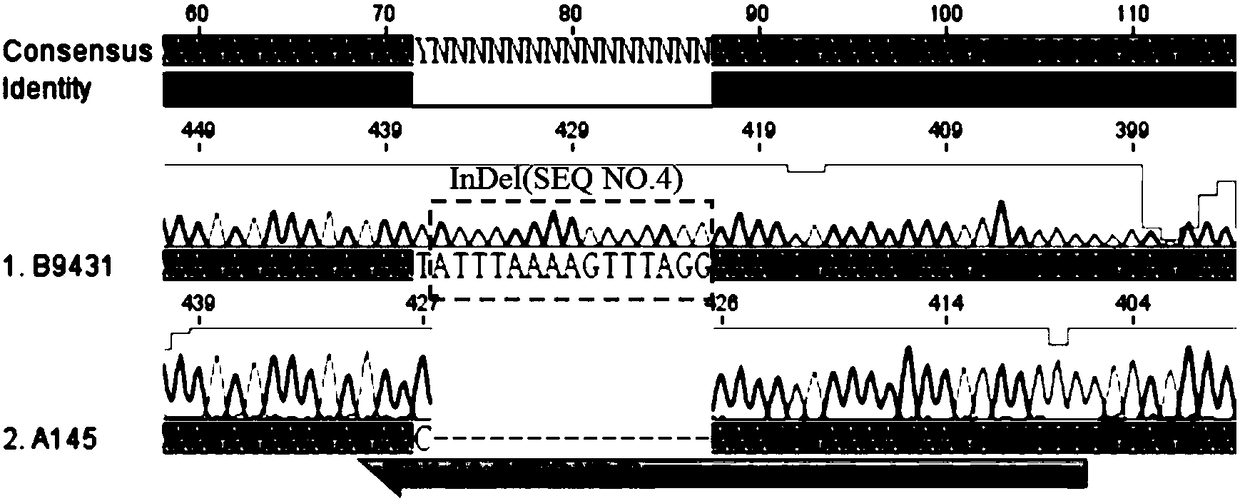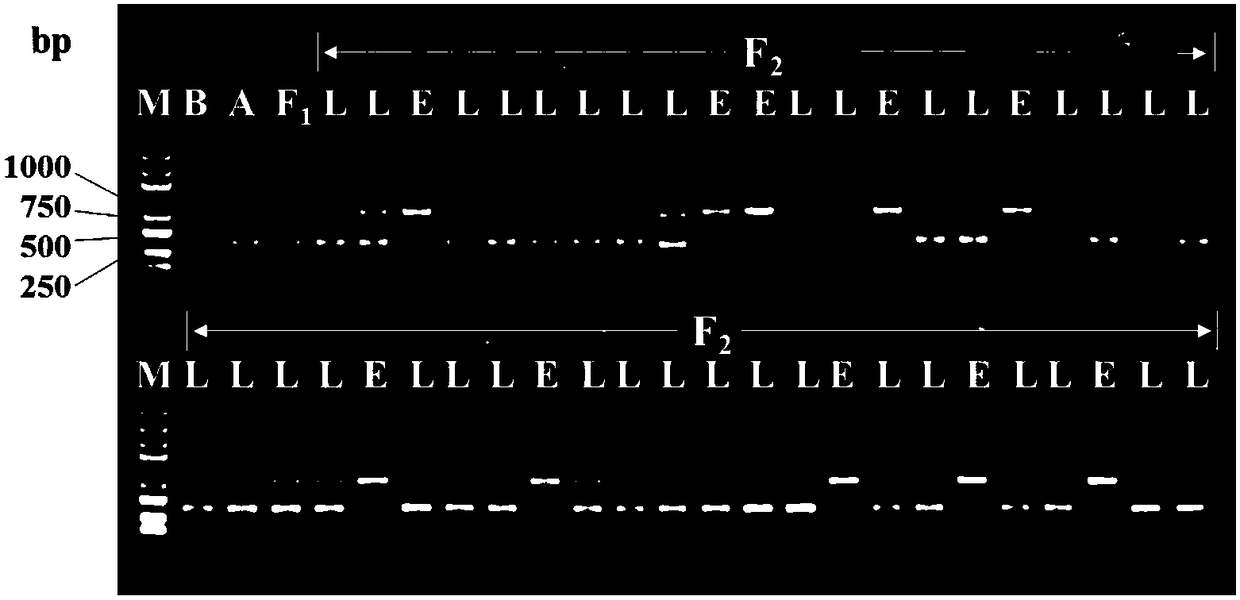InDel molecular marker for identifying pepper maturity and application thereof
A technology of molecular markers and hot peppers, which is applied in recombinant DNA technology, microbial detection/testing, DNA/RNA fragments, etc., can solve the problems of low accuracy of phenotype selection, large limitations in use, and long genetic distance of target genes, etc. problems, to achieve the effect of speeding up the breeding process, high accuracy, and stable amplification
- Summary
- Abstract
- Description
- Claims
- Application Information
AI Technical Summary
Problems solved by technology
Method used
Image
Examples
Embodiment 1
[0030] Example 1 Development of Molecular Marker InDel at the Initiation Node of Capsicum
[0031] 1. Population material construction and genetic analysis
[0032] Extra Early Pepper B 9431 (depending on the planting environment, the first flowering node is 1-4 nodes) as the female parent, late-maturing pepper (depending on the planting environment, the first flowering node is 13-18 nodes)A 145 Crossed for the male parent to get F 1 Generation, F 1 Plants selfed to get F 2 group. Plant this F in spring 2017 2There are 297 plants in the population, and the node position phenotype of flower initiation is measured by the number of true leaves (node positions) between the cotyledon and the first flower on the main stem. The statistical results show that the node position of flower initiation in this population is bimodal, indicating that There are 215 late-maturing plants with high flower-start nodes (≥5) and 82 ultra-early-maturing plants with low flower-start nodes (≤4)...
Embodiment 2
[0037] Example 2 Application of Molecular Marker InDel at the Initiation Node of Capsicum 1
[0038] Extract parent B by CTAB method 9431 , parent A 145 , F 1 Plant (B 9431 ×A 145 ) and 297 F 2 For plant DNA, the DNA concentration was detected with a Nanodrop spectrophotometer, and ddH was added 2 O Adjust all DNA concentrations to 100 ng / μL. Perform PCR according to the following conditions: the total reaction volume is 10 μL, including 5 μL of Kangwei Century Biotechnology Co., Ltd. 2×Es Taq MasterMix (Dye) (CW0690), forward primer FFN1-5UF5 (10 μM) and reverse primer FFN1-e1R1 ( 10 μM) 0.08 μL each, reverse primer FFN1-PA-R (10 μM) 0.4 μL, 100 ng / μL DNA template 0.6 μL, ddH 2 O 3.84 μL. PCR reaction program: pre-denaturation at 95°C for 2min; denaturation at 95°C for 30s, annealing at 56°C for 30s, extension at 72°C for 40s, 38 cycles; extension at 72°C for 10min. Take 3 μL of the PCR reaction product for electrophoresis detection, see image 3 . It was found tha...
Embodiment 3
[0039] Example 3 Application of Molecular Marker InDel at the Initiation Node of Capsicum Pepper 2
[0040] Extra Early Pepper B 9431 (first flower nodes 1-4 nodes) and late-maturing pepper B 025 F 1 Generation, F 1 Plants selfed to get F 2 group. Plant this F in spring 2017 2 Population plants, randomly select wherein 61 strains extract DNA, press the same condition in embodiment 2 to parent, F 1 and F 2 The plants were subjected to PCR, and 3 μL of PCR reaction products were taken for electrophoresis detection, and the electrophoresis results of some amplified products were shown in Figure 4 . The results showed that the genotype identified by this marker was consistent with the plant phenotype, that is, the band type was the same as that of the extra precocious parent B 9431 Consistent with the ultra-early-maturing peppers at the first flower node ≤ 4, the belt type is the same as that of the late-maturing parent A 025 or F 1 The relatively late-maturing peppers...
PUM
 Login to View More
Login to View More Abstract
Description
Claims
Application Information
 Login to View More
Login to View More - R&D
- Intellectual Property
- Life Sciences
- Materials
- Tech Scout
- Unparalleled Data Quality
- Higher Quality Content
- 60% Fewer Hallucinations
Browse by: Latest US Patents, China's latest patents, Technical Efficacy Thesaurus, Application Domain, Technology Topic, Popular Technical Reports.
© 2025 PatSnap. All rights reserved.Legal|Privacy policy|Modern Slavery Act Transparency Statement|Sitemap|About US| Contact US: help@patsnap.com



